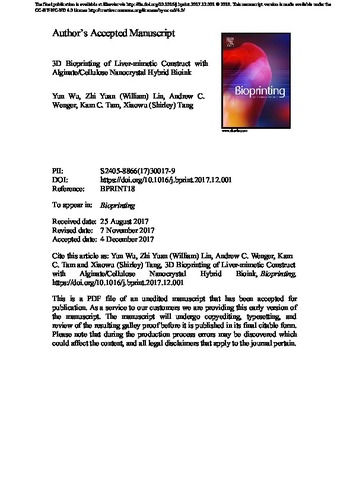| dc.contributor.author | Wu, Yun | |
| dc.contributor.author | Lin, Zhi Yuan (William) | |
| dc.contributor.author | Wenger, Andrew | |
| dc.contributor.author | Tam, Kam C. | |
| dc.contributor.author | Tang, Xiaowu (Shirley) | |
| dc.date.accessioned | 2018-01-16 21:22:55 (GMT) | |
| dc.date.available | 2018-01-16 21:22:55 (GMT) | |
| dc.date.issued | 2018-03-01 | |
| dc.identifier.uri | https://doi.org/10.1016/j.bprint.2017.12.001 | |
| dc.identifier.uri | http://hdl.handle.net/10012/12866 | |
| dc.description | The final publication is available at Elsevier via http://dx.doi.org/10.1016/j.bprint.2017.12.001 © 2018. This manuscript version is made available under the CC-BY-NC-ND 4.0 license http://creativecommons.org/licenses/by-nc-nd/4.0/ | en |
| dc.description.abstract | 3D bioprinting is a novel platform for engineering complex, three-dimensional (3D) tissues that mimic real ones. The development of hybrid bioinks is a viable strategy that integrates the desirable properties of the constituents. In this work, we present a hybrid bioink composed of alginate and cellulose nanocrystals (CNCs) and explore its suitability for extrusion-based bioprinting. This bioink possesses excellent shear-thinning property, can be easily extruded through the nozzle, and provides good initial shape fidelity. It has been demonstrated that the viscosities during extrusion were at least two orders of magnitude lower than those at small shear rates, enabling the bioinks to be extruded through the nozzle (100µm inner diameter) readily without clogging. This bioink was then used to print a liver-mimetic honeycomb 3D structure containing fibroblast and hepatoma cells. The structures were crosslinked with CaCl2 and incubated and cultured for 3 days. It was found that the bioprinting process resulted in minimal cell damage making the alginate/CNC hybrid bioink an attractive bioprinting material. | en |
| dc.description.sponsorship | Natural Sciences and Engineering Research Council (NSERC) of Canada (grant no. RGPIN-2016-04398) | en |
| dc.language.iso | en | en |
| dc.publisher | Elsevier | en |
| dc.rights | Attribution-NonCommercial-NoDerivatives 4.0 International | * |
| dc.rights.uri | http://creativecommons.org/licenses/by-nc-nd/4.0/ | * |
| dc.subject | Alginate | en |
| dc.subject | Bioprinting | en |
| dc.subject | Cellulose nanocrystals | en |
| dc.subject | Liver-mimetic structure | en |
| dc.subject | Tissue engineering | en |
| dc.title | 3D bioprinting of liver-mimetic construct with alginate/cellulose nanocrystal hybrid bioink | en |
| dc.type | Article | en |
| dcterms.bibliographicCitation | Wu, Y., Lin, Z. Y. (William), Wenger, A. C., Tam, K. C., & Tang, X. (Shirley). (2018). 3D bioprinting of liver-mimetic construct with alginate/cellulose nanocrystal hybrid bioink. Bioprinting, 9, 1–6. https://doi.org/10.1016/j.bprint.2017.12.001 | en |
| uws.contributor.affiliation1 | Faculty of Science | en |
| uws.contributor.affiliation2 | Chemical Engineering | en |
| uws.contributor.affiliation2 | Chemistry | en |
| uws.contributor.affiliation2 | Waterloo Institute for Nanotechnology (WIN) | en |
| uws.typeOfResource | Text | en |
| uws.peerReviewStatus | Reviewed | en |
| uws.scholarLevel | Faculty | en |


